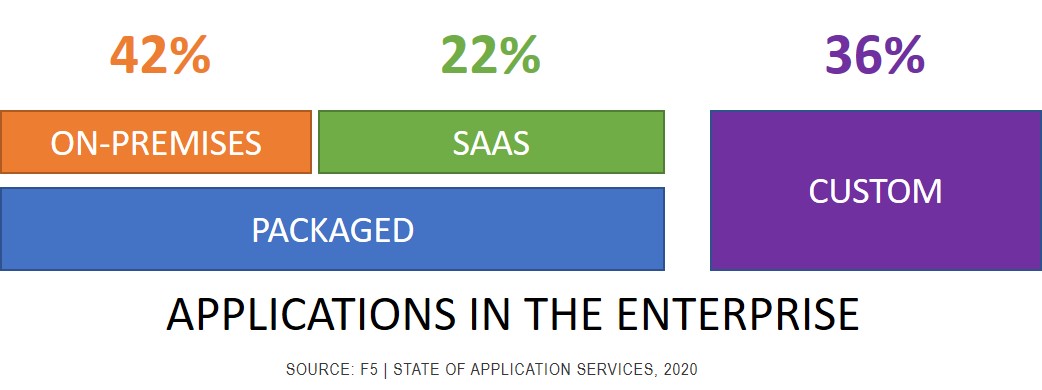Empacotamento e mudança para SaaS
Se você está empacotando seu software local e migrando para SaaS, você não está sozinho.
Desde os primórdios da nuvem, a maior parte da adoção foi (e continua sendo, nesse sentido) em SaaS. O mesmo software que antes era comoditizado e empacotado para ser vendido a empresas agora está sendo oferecido como um serviço via nuvem. Isso não é novo nem diferente. Os mais antigos, como eu, lembram-se bem dos dias do ASP (Application Service Provider), antes de ele ser abruptamente renomeado para nuvem porque, bem, a nuvem era mais legal. E por mais frio, quero dizer mais quente.
Mas, embora o SaaS não seja realmente tão novo, o que é novo é a gama de atividades que estão sendo transformadas em commodities e empacotadas como SaaS. Todos os tipos de funções empresariais estão unindo CRM, SFA, produtividade e comunicações como ofertas de SaaS.
E prevemos que as organizações rapidamente aproveitarão a oportunidade de transferir a operação desse software para um fornecedor.
Não estamos sozinhos.
Os entrevistados da pesquisa de Computação em Nuvem de 2020 do IDG também "esperam reduzir o uso de software licenciado comercialmente (atualmente de 65% para 50%) nos próximos 18 meses em favor de aplicativos de software como serviço (SaaS) (aumento de 24% para 36%)".
Os grandes vencedores são os serviços de TI relacionados à continuidade dos negócios, como backup, recuperação, armazenamento e arquivamento. Não é de surpreender que essa categoria seja acompanhada por funções empresariais comoditizadas, como CRM, ERP, RH e outros aplicativos de linha de negócios. Normalmente, os aplicativos que migram para SaaS são aqueles que não oferecem retornos de alto valor quando personalizados. Um procedimento/processo operacional padrão atende bem ao negócio, de modo que os recursos são melhor investidos em outras áreas onde a personalização do processo produzirá resultados de maior valor.
Isso é especialmente verdadeiro quando o SaaS oferece suporte a um ecossistema que torna a integração um problema irrelevante. Uma quantidade significativa de esforço de desenvolvimento é destinada à integração, que é essencialmente a implementação técnica de unir um processo. Ou, em termos modernos, um fluxo de trabalho digital . Quando os provedores de SaaS fazem o trabalho duro e permitem a integração de caixas de seleção para estabelecer esse fluxo de trabalho, eles vencem.
O retorno da TI como serviço
Outra área de adoção de SaaS menos mencionada é no espaço de infraestrutura de TI. Não a infraestrutura em si, mas grande parte dos aspectos operacionais da infraestrutura do segundo dia e além, como provisionamento, configuração, operação e relatórios sobre serviços de aplicativos. Como porcentagens significativas de profissionais de TI continuam trabalhando em casa, o acesso à infraestrutura do data center (e baseada na nuvem) se tornou um recurso essencial para que eles realizem seu trabalho. Modelos tradicionais que isolam redes de gerenciamento do acesso externo podem prejudicar esses recursos. Uma abordagem mais moderna, baseada em SaaS, mantém o controle de acesso e a proteção necessários para proteger essas funções críticas, ao mesmo tempo em que permite que os profissionais de TI operem a infraestrutura de qualquer lugar.
Além disso, os fluxos de trabalho geralmente não são muito diferenciados e, portanto, oferecem pouca vantagem competitiva ou comercial. O processo de implantação dos dez serviços de aplicativo necessários para entregar e proteger um aplicativo é padronizado da perspectiva de um serviço de aplicativo. Embora os serviços de aplicativos em si forneçam recursos diferenciados, os processos de gerenciamento geralmente não o fazem. Eles atendem aos requisitos básicos para migrar para um modelo baseado em SaaS.
Este não é um conceito novo. Falei sobre isso há dez anos no contexto do movimento Infraestrutura 2.0 (vá até a discussão sobre o parfait arquitetônico). Embora muitos aspectos da tecnologia tenham mudado desde então, a necessidade de sobrepor recursos operacionais na nuvem e nos data centers não mudou. Na verdade, o modelo operacional multi-nuvem de fato, juntamente com uma nova urgência por recursos de trabalho remoto, apenas exacerbou a necessidade de modelos de gerenciamento baseados em SaaS que ofereçam suporte à infraestrutura implantada em data center e nuvem com igual presteza.
Espere ver um aumento na entrega de recursos tradicionais de gerenciamento de infraestrutura por meio de um modelo SaaS nos próximos anos, à medida que nos adaptamos ao novo normal de multinuvem e trabalhamos de qualquer lugar.

